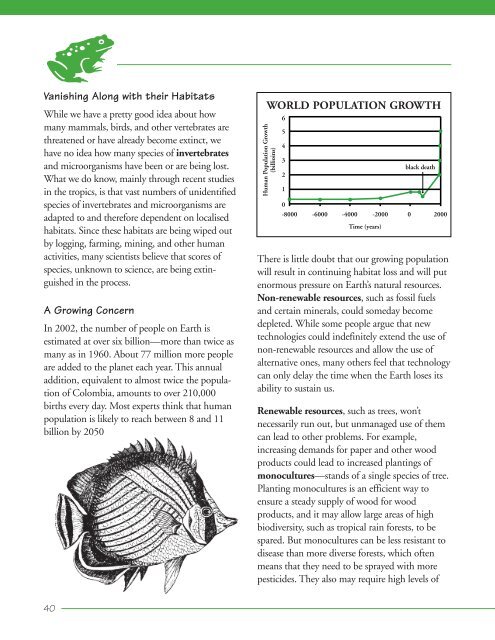EXPLORING BIODIVERSITY: A Guide for Educators Around the World
EXPLORING BIODIVERSITY: A Guide for Educators Around the World
EXPLORING BIODIVERSITY: A Guide for Educators Around the World
You also want an ePaper? Increase the reach of your titles
YUMPU automatically turns print PDFs into web optimized ePapers that Google loves.
q<br />
Vanishing Along with <strong>the</strong>ir Habitats<br />
While we have a pretty good idea about how<br />
many mammals, birds, and o<strong>the</strong>r vertebrates are<br />
threatened or have already become extinct, we<br />
have no idea how many species of invertebrates<br />
and microorganisms have been or are being lost.<br />
What we do know, mainly through recent studies<br />
in <strong>the</strong> tropics, is that vast numbers of unidentified<br />
species of invertebrates and microorganisms are<br />
adapted to and <strong>the</strong>re<strong>for</strong>e dependent on localised<br />
habitats. Since <strong>the</strong>se habitats are being wiped out<br />
by logging, farming, mining, and o<strong>the</strong>r human<br />
activities, many scientists believe that scores of<br />
species, unknown to science, are being extinguished<br />
in <strong>the</strong> process.<br />
A Growing Concern<br />
In 2002, <strong>the</strong> number of people on Earth is<br />
estimated at over six billion—more than twice as<br />
many as in 1960. About 77 million more people<br />
are added to <strong>the</strong> planet each year. This annual<br />
addition, equivalent to almost twice <strong>the</strong> population<br />
of Colombia, amounts to over 210,000<br />
births every day. Most experts think that human<br />
population is likely to reach between 8 and 11<br />
billion by 2050<br />
WORLD POPULATION GROWTH<br />
There is little doubt that our growing population<br />
will result in continuing habitat loss and will put<br />
enormous pressure on Earth’s natural resources.<br />
Non-renewable resources, such as fossil fuels<br />
and certain minerals, could someday become<br />
depleted. While some people argue that new<br />
technologies could indefinitely extend <strong>the</strong> use of<br />
non-renewable resources and allow <strong>the</strong> use of<br />
alternative ones, many o<strong>the</strong>rs feel that technology<br />
can only delay <strong>the</strong> time when <strong>the</strong> Earth loses its<br />
ability to sustain us.<br />
Renewable resources, such as trees, won’t<br />
necessarily run out, but unmanaged use of <strong>the</strong>m<br />
can lead to o<strong>the</strong>r problems. For example,<br />
increasing demands <strong>for</strong> paper and o<strong>the</strong>r wood<br />
products could lead to increased plantings of<br />
monocultures—stands of a single species of tree.<br />
Planting monocultures is an efficient way to<br />
ensure a steady supply of wood <strong>for</strong> wood<br />
products, and it may allow large areas of high<br />
biodiversity, such as tropical rain <strong>for</strong>ests, to be<br />
spared. But monocultures can be less resistant to<br />
disease than more diverse <strong>for</strong>ests, which often<br />
means that <strong>the</strong>y need to be sprayed with more<br />
pesticides. They also may require high levels of<br />
40

















